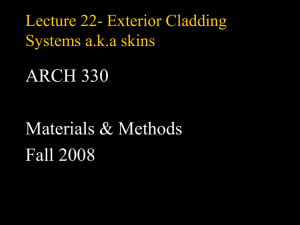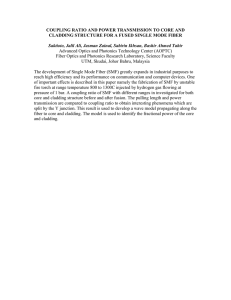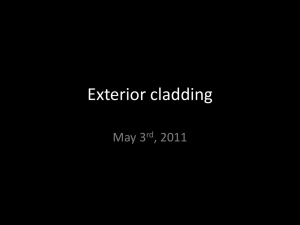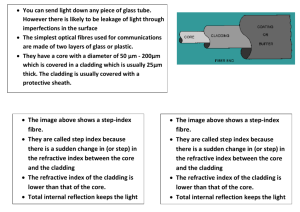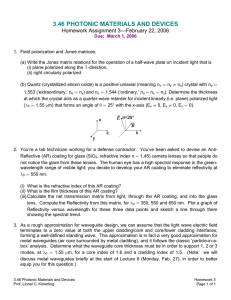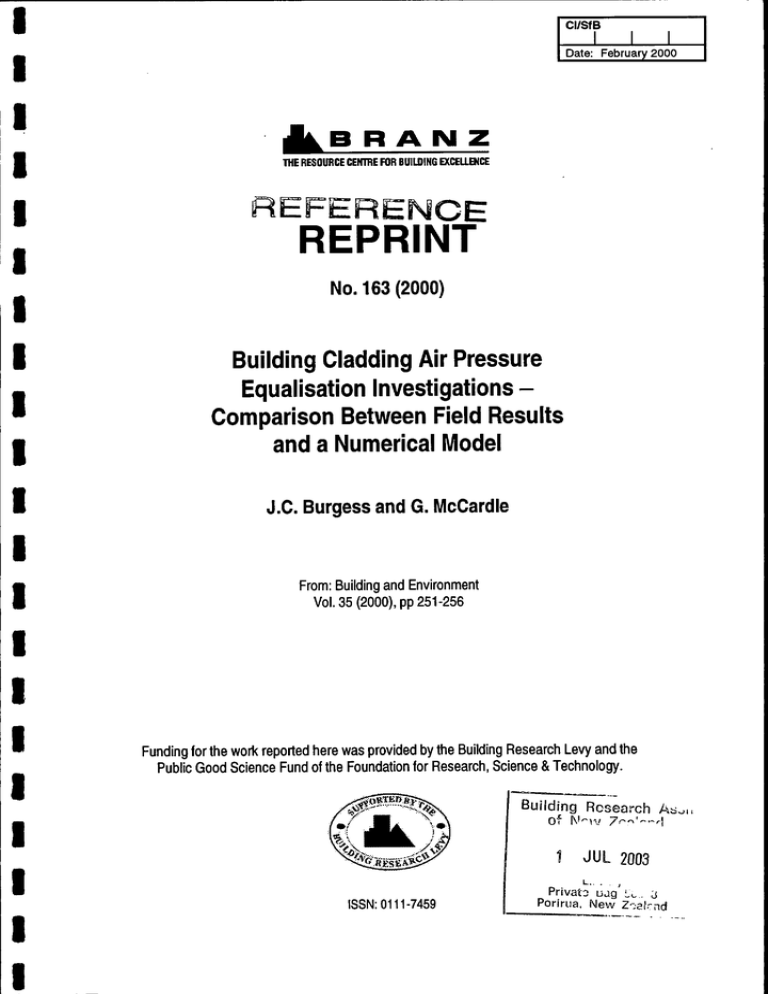
I
I
I
Date: February 2000
THE RESOURCE CENlRE FOR BUILDING EXCEUENCE
REPRINTNo. 163 (2000)
Building Cladding Air Pressure
Equalisation Investigations Comparison Between Field Results
and a Numerical Model
J.C. Burgess and G. McCardle
From: Building and Environment
Vol. 35 (2000),pp 251 -256
Funding for the work reported here was provided by the Building Research Levy and the
Public Good Science Fund of the Foundation for Research, Science & Technology.
L.
ISSN: 01 11-7459
.
.
I
Privalr: u ~ gLL.. ;L
Porirua, New Z-,zlrnd
.
1
-
.
.
PERGAMON
Building and Environment 35 (2000)251-256
www.elsevier.comflocate/buildenv
Building cladding air pressure equalisation investigationscomparison between field results and a numerical model
J.C. Burgess*, G. McCardle
BRANZ, Private Bag 50908. Moonshine Road. Judgeford, Porirua, New Zealand
Received 20 October 1998;received in revised form 8 February 1999;accepted 29 March 1999
Abstract
Experimental measurements of the air pressure differentials across the outer cladding layers on four buildings have been made,
to assess .the likely weathertightness performance of the cladding systems due to the mechanism of pressure equalisation. Results
for two of these four buildings verify the pressure equalisation percentages predicted through the use of the numerical model
PERAM. 0 2000 Elsevier Science Ltd. All rights reserved.
1. Introduction
One of the major requirements of the external cladding of a building is to prevent the ingress of water
under all climatic conditions.
Two disparate ideologies within the commercial
cladding industry have developed to address this issue
of achieving weathertightness in high-rise construction.
These techniques may be broadly classified as 'Sealed
jointed' or 'Rainscreen jointed' methods. A sealed
jointed cladding must be formed of a 'skin' impervious
to water and air. As both the environmental fluids
(water and air) are present at the same point in sealed
jointed cladding systems in the form of rain and wind,
the slightest imperfection in the skin can result in
weathertightness failure. In contrast, a rainscreen
jointed cladding system separates the weathertightness
functions of joints in order to achieve weathertightness. Neither of these functions, wind exclusion and
water exclusion, require perfection in construction to
perform adequately.
Birkeland [l] and Garden (21 first reported on the
rainscreen principle in the early 1960's. This resulted in
detailed investigation of the new realms opened up to
Corresponding author. Tcl.: + 64-235-7600;fax: + 64-235-6070.
E-mailoddre=: branzjcb@branzorg.nz (J.C. Burgess).
-
the cladding designer and the development of the following jointing systems: the drained joint system [3],
the two stage joint [4], the rainscreen joint [5,6], the
pressureequalised joint [7,8], and the pressurised cavity joint [9] systems. These joint types all, to some
degree, implement the rainscreen principle propounded
by Garden and Birkeland in the early 1960's. Other
researchers [lo] have developed these ideas to allow reduction in cladding design loadings [ll], as well as
cross-cladding differential pressure reductions [12],
with Kerr providing a good bibliographic database
[131.
I . I . Rainscreen cladding
The operational aim of a rainscreen cladding is to
allow the passage of air through a restricted opening
into a cavity between the building interior and the exterior cladding. Horizontal and vertical compartmentalisation of joint cavities behind the facade is necessary
to restrict transverse flows of air behind the cladding,
and cavity venting is through (ideally) a single opening
such that the joint cavity is subject to a single isobaric
field at any one time.
This imparts a high PEP (pressure equalisation percentage-see Eq.(1)) such that the differential pressure
across the potentially wet exterior face of the joint is
maintained too low to form a significant driving force
0360-1323/00/S see front matter 0 2000 Elsevier Science Ltd. All rights r e ~ e ~ e d .
PII: SO36O-I323(99)OOO22-O
252
J.C. Burgess. G. McCardle / Building and Environment 35 (2000) 251-256
Nomenclature
external joint opening area [mm2]
coefficient of flow through external cladding
layer
k2 coefficient of flow through internal cladding
layer
P
amplitude of external air gauge pressure [Pa]
pb
gauge air pressure in building interior [Pa]
Pc(t) gauge air pressure within joint cavity at time 1
[Pal
A.
kl
to transport liquid water to the interior of the joint,
and the weathertightness of the joint is increased.
The quantitative determination of the weathertightness of a PER (Pressure Equalised Rainscreen) construction joint through the action of air pressure
equalisation was not possible prior to the development
of equations describing this behaviour [14] and the
consequent numerical models [12]. However, experimental verification of these numerical processes has
been instigated by Baskaran [IS]. This
describes
the experimental determination of the PEP of three
cladding types and presents an investigation into cladding cavity compartmentalisation. It also reveals the
deficiency in knowledge of raindrop trajectory response
to air pressure fluctuation frequency.
1.Z. Pressure Equalised Rainscreen joints
The differential air pressure acting across an opening
of a PER joint can be a cause of weathertightness failure for the joint, so the PEP was designed to provide a
measure of this pressure differential. The PEP, as
defined by Burgess [14], is a specific value between 0
and 100% which measures the rapidity and degree to
which the internal air pressure within a joint cavity
can equalise with the external air pressure, when the
joint is subjected to sinusoidal air pressure fluctuations
at a specific frequency. A PEP can be calculated from
a time history of the air pressures within and outside a
PER joint with the equation given below, as derived
by Burgess [12].
A PEP value of 100% implies that the internal cavity
pressure is completely in phase with, and of an identical amplitude to, the driving air pressure, so that at all
times the differential pressure across the interface is
zero.
The PEP is frequency dependent, and although there
is yet no study linking the PEP at different driving fre-
P,(r) gauge air pressure outside joint cavity at time
t [Pal
PEP Pressure Equalisation Percentage [%I
PER Pressure Equalised Rainscreen joint [acronym]
T
period [s]
Vc
volume of joint cavity [l]
f
frequency [Hz]
quencies with rain water leakage rates through openings in ioints. a figure of PEP=95% at 3 Hz has been
sekzted as ah appropriate benchmark for PER joints
(121.
I
2. Experimental
Two different cladding forms with three different
approaches to pressure equalisation were identified on
four high-rise buildings within the city of Wellington,
New s a l a n d . The cladding- types
were as follows.-1. Vented precast concrete panel, hung over a backing
wall. Building A-Fig. 1.
2. Precast concrete panels with baffled joints over a
backing wall, Building B-Figs. 2 and 3.
3. Ceramic tiles hung over a galvanised steel backpan,
Buildings C&D-Fig. 4.
-
I1
-
The experimental procedure involved positioning air
pressure tappings at several locations around each
cladding to measure the static and dynamic external
GROOVE CAST
ISOMETRIC TYPICAL
DOUBLE KERF BRACKET
Fig. I . Isothedc typical do1rblc kcr
I
J.C. Burgess, G. McCardle / Building and Environmenr 35 (2000) 251-256
253
between measurement locations were introduced with
this approach, so that only data acquired at below
10 Hz was utilised in this work.
Logging of the air pressure environment around the
cladding of these buildings, and the air pressure fluctuations due to wind incidence and resultant air pressure
equalisation, was undertaken intermittently over a
three year period to obtain a variety of weather conditions, with at least 90 data sets per building.
2.1. Building A
Fig. 2. Horizontal section, vertical joint.
air pressure, the building internal air pressure, and the
joint cavity air pressure. To take the external and cavity air pressure measurements P, and PC,an air pressure logging head was connected to a pair of bidirectional differential pressure transducers, interfaced
to a METRABYTE EXP-RES signal conditioning
multiplexer and pc-based data acquisition system, with
the pressures referenced to the internal building air
pressure, Pb. This static air pressure measurement, P b
was made with a device described by Bassett [la
which performs an averaging over the air pressure environment surrounding the device. A PC-based datalogging system running data acquisition routines in
BASIC, was utilised to record data sets logging high
wind pressure events over a certain threshold, such
that the variables within Eq. (1) could be recorded, to
enable an experimental determination of the degree of
air pressure equalisation to be made. The data acquisition rate was set at 1 kHz, although phase differences
This building has precast concrete cladding panels
which are hung (see Fig. 1) over a concrete block
backup wall with seals along the extent of the panel
horizontal joints, and down the vertical joints, cut
60 rnm short of the cruciform joint to provide a slot
for the air pressure equalisation of the cladding.
However, the cladding cavity is not compartmentalised, and the foot and jambs of termination panels are
open, such that air flows are unrestricted within the
cladding cavity.
Four pressure measurement sites were chosen in
August-December 1995 on the Clevel western elevation of this site on the waterfront in Wellington,
New Zealand. There was considerable exposure to the
north and west, with the prevailing wind pattern at
this site from the north. Sites 1 and 2 were at the third
and second levels of the cladding facade, respectively,
where logging was performed before the joint cavity,
which extends the full length and height of the facade,
had been sealed at all its horizontal joints, and at its
head, foot and ends. Sites 3 and 4 were at adjacent locations to sites 1 and 2, with logging performed after
the cladding cavity had been sealed at all its joints,
head and foot in November 1995.
,
/
PLAN
Galvanised
steel
backpan
I
Ceramic
cladding
+ki
Panel
holding
clip
ELEVATION
Fig. 3. Horizontal detail, vertical joint.
Fig. 4. Plan and elevation of joint.
J.C. Burgess. G. McCardle / Building and Environment 35 (2000) 251-256
254
Table I
Experimental data: PEP values for the four buildings
2.2. Building B
Building B is a 32 level construction completed in
1990 on an elevated site within the Wellington CBD.
A very similar approach was taken for the data acquisition on Building B as was performed on the Building
A cladding. Two datalogging sites were selected on the
16th level of the facade, with the joint detail shown in
Figs. 2 and 3. The cladding type is similar to that of
Building A and the jointing is composed of loose fitting baffles within the panel edge joints, without
designed joint opening areas. This differs significantly
from the Building A example, which has tube seals
and designed opening areas. The joint cavity is taken
to extend between cruciform joints for the height of
the 800 mm wide panel behind the baffle. The joint
opening area is a 20 mm wide slit the height of the
panel, which varied from 1.2 to 1.8 m high.
Building name
A
B
C
D
No. of runs
Mean
Standard deviation
820
69
12
515
65
I2
94
59
15
1221
59
14
through the city to the west. The north-west facade
was utilised to obtain air pressure fluctuation records
in late 1997, including some severe storm conditions.
The ceramic cladding panels of 600 x 300 mm and
attachment detail was the same as that applied to
Building C, except that both the cladding cavity
volume and joint opening area were three times larger.
The general joint details conform to Fig 4.
2.3. Building C
2.5. Data analysis
This is a 14 level building located within the
Wellington CBD. Datalogging operations were undertaken in early 1997 on the ceramic cladding panels
hung over a galvanised steel backpan. The general
joint details are shown in Fig. 4, (same as Building D)
where the cavity was compartmentalised into 1.8 m
high, 0.3 m wide sections, formed by the ribs of the
trough-section galvanised steel backpan. The 600 mm
wide tiles span two of these compartments, with the
joint opening area around the periphery of the tiles.
There is considerable air leakage between the cavities
of adjacent panels.
The experimental data was fed to a purpose-built C
program running on a PC incorporating a suite of
'Numerical Recipes' [17] FFT methods to filter and
correlate the data.
As the PEP is frequency dependent, Fourier
methods were used to filter the data and obtain information at single air pressure driving frequencies for
analysis. The main frequency of interest was 3 Hz, (as
this is a suitable representative frequency for a PEP
measurement-see [12]) although frequencies over an
order of magnitude from 0.5 to 5 Hz were analysed,
being within the range of expected air pressure fluctuation frequencies [13]. An FFT cross correlation is
used to determine the phase shift and amplitude modification between the spectral element of the driving signal chosen, and its response. Further C code yields the
PEP of each of the data sets pertinent to the system,
with the results displayed below.
2.4. Building D
This is a four level building on the seafront outside
the Wellington CBD, exposed to a considerable catchment to the north, with restricted wind exposure
0
1
2
3
4
5
Frequency (Hz)
Fig. 5. PEP values by air pressure fluctuation frequency for four Wellington buildings.
J.C. Burgess, G. McCardle / Building and Environmenl35 (2000) 251-256
Table 2
Comparison of experimental and numeric model data for four buildings
Building
PERAM PEP (3)
Building A
Building B
Building C
Building D
71
70
83
85
Mean experimental PEP (3)
3. Results
The range of PEPS at 3 Hz-PEP(3), calculated
from the experimental data at the four buildings is
shown in Table 1, where each individual experimental
run of 200-1000 points yields a PEP for each of the
four buildings.
It was observed that there was no noticeable difference at this frequency between the cladding locations
chosen on any of the buildings, and no difference
between the results from Building A before the cavity
was closed and after it was closed. This indicates that
the volume of air contained in the cavity of Building
A has sufficient inertia that compartmentalisation is
effectively achieved without physical barriers at this
frequency of 3 Hz.
Fig. 5 portrays the PEP's for the four Wellington
buildings at the frequencies investigated in this work.
3.1. Comparison of experimental vs numerical model
results
The numerical model PERAM [14] for calculating
PEPS was fed the relevant design information for the
claddings, including joint opening area, A,, cavity
volume, V., and flow coefficients, kl and k2, together
with parameters relevant to the phase, amplitude and
frequency of the driving air pressure wave. Due to the
noncompartmentalised nature of the cladding cavity
at Building A, and the linkage between cavities at
Building D and Building C, a value of k2= 0.2 (airflow
coefficient through leakage openings) was chosen, as
discussed by Burgess (141, as an input parameter to
PERAM.
The correlation between the experimental and algorithmic representations of the PEP(3) is given in Table
2.
While the comparison between the experimental and
PERAM-numerical PEP's is within 3% for Building
A, and 7% for Building B, the performance of the numerical model PERAM at modelling the ceramic tile
cladding systems of Buildings C and D is 29% and
28% too high, respectively.
255
4. Discussion
The numerical model PERAM is shown to predict
well the PEP at 3 Hz for Buildings A and B. However,
the PERAM predicted results for Buildings C and D
with the ceramic cladding panels do not agree well
with experiment. Theoretically it is expected that the
PEP of these cladding sysJems would be high, as they
incorporate incomplete PER joint design concepts [6].
Upon analysis of the experimental data acquisition
from the two buildings C and D, it was realised that
the datalogging tap locations were (in both buildings)
near to the edge of a bluff face, such that rather than
the expected low velocity air flow environment, the
data logged could well have included a sizeable component of airflow parallel to the plane of the cladding.
The method of pressure measurement included an
assumption that there would not be sizeable air flows
parallel to the cladding, as parallel airflows would tend
to erroneously contribute to the measurement of the
local static air pressure environment. It appears that
the placement of air pressure tappings near to the edge
of the cladding system in Buildings C and D, makes it
uncertain how well the results reflect uncorrupted data
from parallel air flow contamination, such that the
PERAM predictions cannot be well verified for these
buildings.
On the other hand, the PERAM predictions are
good where we can be confident of the integrity of the
data for Buildings A and B. On these buildings, the
logging locations used were within a central portion of
a bluff face, such that stagnation pressures were
expected from wind at normal incidence, that could be
isolated from parallel cross flow through the directional external air pressure measurement method.
4.1. Compartmentalisation
The data obtained from Building A, with a noncompartmentalised cladding cavity, reveals that cavity
compartmentalisation is in this case, not essential to
achieve a degree of pressure equalisation at an external
air pressure fluctuation frequency of 3 Hz. Of course,
a PEP of 65 or 69% at 3 Hz is still not high enough to
impart ensured weathertightness through this mechanism, as the target is over 95% [12]. However, the reduction in the wind pressure differential across the wet
cladding area and consequent reduction in design load
of cladding fixings does impart an advantage over the
sealed cladding approach, where a PEP of 50% is
expected. Typically [12] the PEP is expected to increase
inversely with frequency, although this is not shown in
the results, since it is likely that the noncompartmentalisation of the cladding of Building A has reduced
the experimentally determined PEP.
256
J.C. Burgess, G. McCardlel Building and Environment 35 (2000) 251-256
5. Conclusions
The numerical model PERAM models the pressure
equalisation behaviour of air movement around the
cladding systems constructed on Building A and
Building B at 3 Hz, to within 3 and 7%, respectively,
of that measured experimentally.
Until further work is performed linking the critical
air pressure fluctuation frequencies at which rain drops
will be imparted with sufficient momentum to re-direct
them into cladding cavities, the contribution of the
PEP at 3 Hz (or any other frequency) to the weathertightness of cladding systems cannot be effectively
measured.
It is recognised that work to determine the critical
frequencies at which the trajectories of rain drops of
varying sizes will be altered by air pressure fluctuations, will form an important extension to this work.
Acknowledgements
The funding from the Building Research Levy and
the Public Good Science Fund of the Foundation for
Research, Science and Technology is acknowledged.
References
[I] Birkeland. Curtain Walls. Norwegian Building Research
Institute Handbook I lb. Oslo, 1962.
[2] Garden GK. Rain penetration and its control. Canadian
Building Digest 40, NRCC, 1963.
[3] Bassett MR. Drained joints, case studies. BRANZ (Building
Research Association of New Zealand). 1991.
[4] Brown, Ballantyne ER. Watertight or Weatherproof-application of drained joint principles. Build Forum 1973;23(1):2-8.
151 Ganguli U, Quirouette RL. Pressure equalization performane
of a metal and glass curtain wall. IRC Paper No. 1542. NRCC.
Ottawa. Ontario, Canada, 1988.
[6] Killip IR, Cheetham DD. The prevention of rain penetration
through external walls and joints by means of pressure equalisation. Build Env 1984;19(2):81-91.
[A Baskaran A. Extraction of design guidelines for pressure equaliscd rainscreen walls, Internal Report No. 629, Institute for
Research in Constmction, National Research Council of
Ottawa, 1992.
[8] Fazio P, Kontopidis T. Cavity pressure in rain screen walls.
Build Env 1988;23(2):137-43.
[9] Kontopidis T, et al. Potential of rain screen walls to prevent
rain penetration: prcssurised cavity principle. Building Research
and Information 1993;21(3).
(101 Ganguli U, Dalgliesh WA. Wind pressure on open rain mcen
walls: place air Canada. J Struct Engng 1988;114(3).
[Ill Baskaran A. Brown WC. Performane of pressure qualised
rainmeen walls under cyclic loading. J Thermal Insul Bldg
Envs 1992;16.
(121 Burgess JC. Air pressure equalisation in rainscreened joints by
geometric alteration. Build Env 1995;30(1):13-8.
1131 Kerr DD. Annotated bibliography on the rain screen principle.
NRCC Bibliography No. 45. 1985.
[I41 Burgcss JC. Pressure equalised rainscream joint modelling with
the numerical model PERAM. Build Env 1995;30(3):385-9.
[IS] Baskaran A. A numerical model to elevate the performane of
pressure equalised rainswalls. Accepted for publication in
Build Env 1994.
[ I q Bassctt MR A static air pressure measurement device. BRANZ
(Building Rscarch Association of N n r Zealand) Internal w r t
1985.
[I71 Press. Rannery, Teukolsky. Vetterling. Numerical recipes in C:
the art of scientific computing. Cambridge: Cambridge
University Press, 1992.
THE RESOURCE CENTRE FOR BUILDING EXCELLENCE
To be the leading resource
for the development of the
building and construction industry
HEAD OFFICE AND LABORATORIES
Moonshine Road, Judgeford
Postal Address - Private Bag 50903, Porirua City
Telephone - (04) 235-7600, Fax - (04) 235-6070
Internet - http:/ / www.branz.org.nz
E-mail - postmaster@branz.co.nz
NEW ZEALAND OFFICES
AUCKLAND
Telephone - (09) 303-4902 (900)
Fax - (09) 303-4903
The Building Technology Centre
Victoria Park, 17 Drake Street
PO Box 90524, Auckland Mail Centre
CHRISTCHURCH
Telephone - (03) 366-3435
Fax - (09) 366-8552
GRE Building
79-83 Hereford Street
PO Box 496
AUSTRALIAN OFFICE
Telephone - (006 12) 9960 0072
Fax - (006 12) 9960 0066
Level 1 Bridgepoint, 3 Brady Street, Mosman, Sydney
PO Box 420, Spit Junction, NSW 2088

